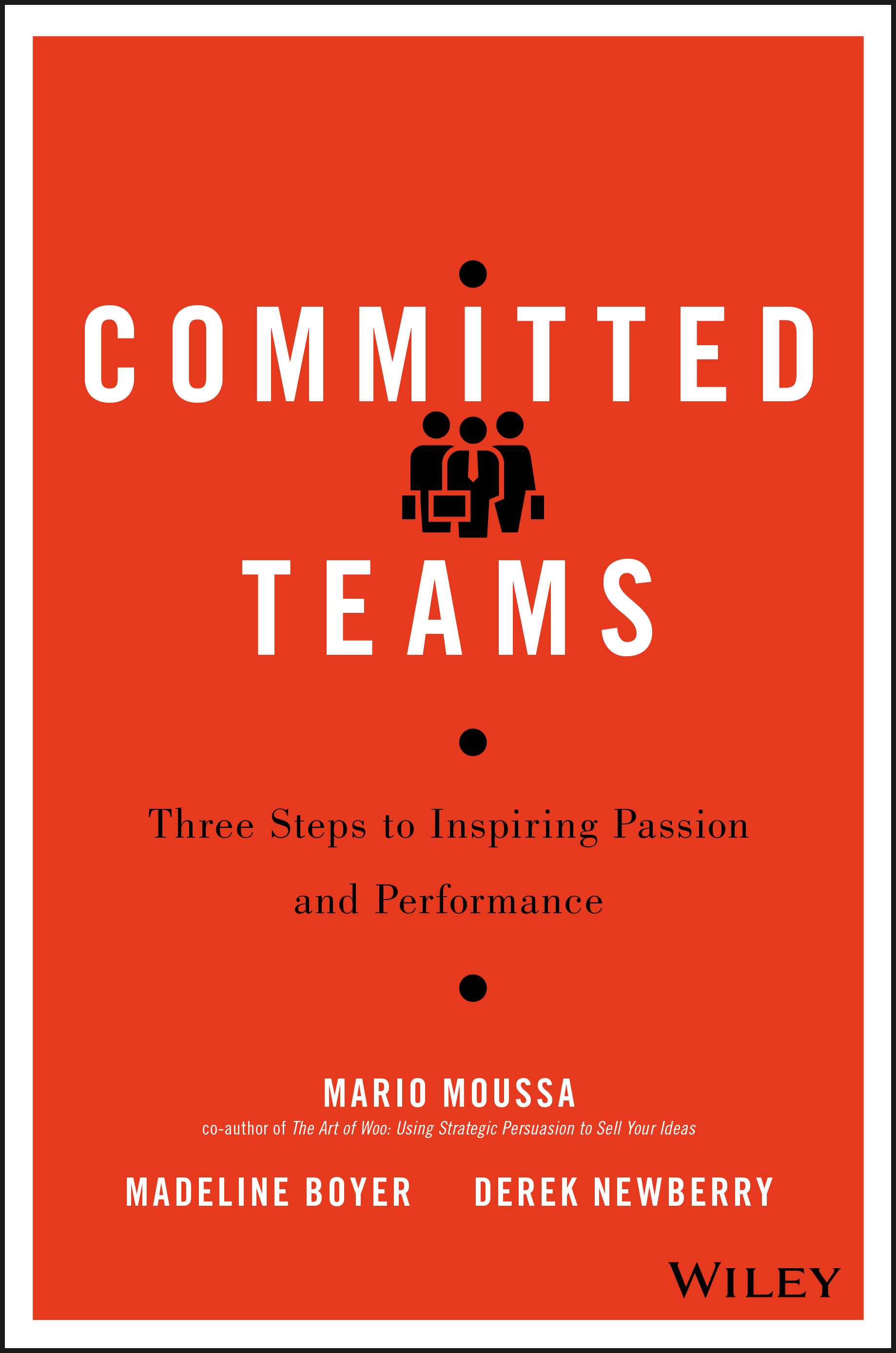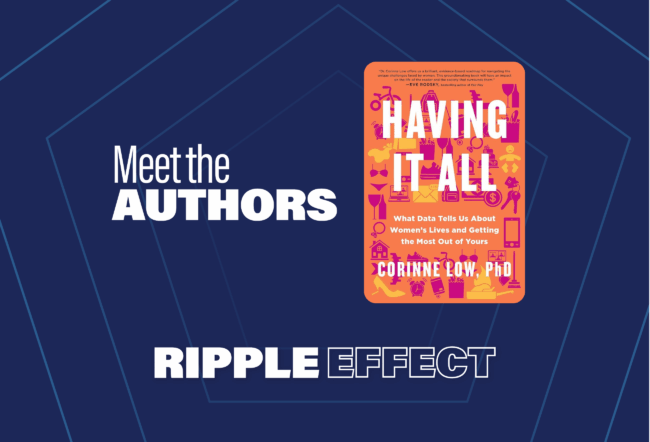 What makes certain teams excel and others perform below par? In a new book, Committed Teams: Three Steps to Inspiring Passion and Performance, Mario Moussa, Madeline Boyer and Derek Newberry divulge the surprising secrets to developing a high-performance team and the common mistakes groups make that hinder their cooperation.
What makes certain teams excel and others perform below par? In a new book, Committed Teams: Three Steps to Inspiring Passion and Performance, Mario Moussa, Madeline Boyer and Derek Newberry divulge the surprising secrets to developing a high-performance team and the common mistakes groups make that hinder their cooperation.
Jeffrey Klein, executive director of the McNulty Leadership Program at Wharton, recently spoke with Moussa, a Wharton Executive Education fellow, about his new book.
An edited transcript of the conversation follows.
Jeffrey Klein: Mario, I’ve known you for some time, and your interests range from influence to negotiation to organizational performance. This is a book about teams — specifically, committed teams. What led you to write this book now?
Mario Moussa: For the past three years, my co-authors and I have been involved in Wharton’s Executive Development Program (EDP). Three times a year, EDP brings in around 60 executives from around the world. They come here, they take courses, they take sessions about leadership and finance and marketing and so on, and then there is a very intense immersive simulation.
The third part of the program is teamwork. They form into teams, and they compete with each other for two weeks … within the simulation. The environment is very realistic, so tensions run high. There is euphoria, lots of competition, lots of collaboration.
The EDP is a living laboratory in which we have had the opportunity to observe, as we like to say, 100 teams forming and competing with each other [over] more than 100 simulated years. We like to think of this living laboratory as an opportunity to do a lot of fieldwork. Over that time, we have gathered lots of data, and all that data now is captured in our book, in a framework that we call the 3×3.
Klein: If I’m not mistaken, your two co-authors, Derek Newberry and Madeline Boyer, both come at this work from [a viewpoint based on their] anthropological training. So it must have been heaven for them to watch 100 teams forming and evolving over time.
Moussa: That’s exactly it. Derek and Maddy were trained as cultural anthropologists — or business anthropologists, really. Then we work with a number of other observers. We call this the High-Performing Team [HPT] of observers. Most of them are trained social scientists or anthropologists.
What they excel in is observing. We love to quote the great philosopher, Yogi Berra, “You can observe a lot just by watching.” Most of the time, we’re not watching because we’re distracted. So we’ve really focused in on the experience that these teams have had, as I said, forming and competing, and we’ve learned a lot from that.
Klein: You mentioned the 3×3 Framework, which has come out of these observations. Can you describe that for us a little bit?
Moussa: What we found is, when they’re getting started on a task, high-performing teams focus on three things: goals, roles and norms. That’s the first part of the 3×3. If you look at the team’s literature, you will find versions of those basic foundations again and again. So I wouldn’t say that was all new, although we’ve streamlined the framework a little bit, in that respect. But we also find that teams need to continually revisit those foundations in the three steps that we mentioned in the title. So step one is to commit to shared goals, roles and norms.
“High-performing teams focus on three things: goals, roles and norms.”
Klein: What I hear in that is, there is something about being explicit about what those goals, roles and norms are.
Moussa: Absolutely — [being] explicit and having a good conversation about having those three things. Maybe we could come back to, how do have a really good conversation? Then, given that there are all kinds of pushes and pulls in the typical workday … you may be working on multiple projects. You have commitments outside of work. So you’re distracted, and you’re going in many different directions. Over time, naturally, almost inevitably there is drift on teams, around those goals, roles and norms. So you need to revisit them. We found that high-performing teams check in from time to time.
Klein: What does that look like?
Moussa: It’s going back to those original commitments: What do we want to do? How do we want to work together? How are we going to share information, make decisions, and so on and so forth? Are we still committed to those things initially that we talked about? If not, how are we going to close the gap between what we say we want to do and what we’re actually doing? Which leads to the third step, which we call “close,” and the key activity there is closing the gap — closing the saying-doing gap, as we like to put it.
What we found is that the most effective way to close that gap is in small steps … targeted at really specific changes, with attention paid to the environment in which the team is working and attempts made to create an environment that supports taking those small steps, and then being realistic about what you can do and what you can’t do. We like to say realistic optimists do better than pure optimists, because realistic optimists think ahead about what can get in the way of doing what they want to do.
So the 3×3, in sum, is initial conversation about goals, roles and norms, and then checking in from time to time, and then working to close the gap between what you’re actually doing and what you say you want to do, and then doing that again and again and again. That’s an iterative process. The key to doing that well is having a really good conversation or really paying attention to what is happening on the team. It turns out that it’s really hard to pay attention.
Klein: Absolutely. As I think about the teams that I’m a part of now and the teams that I’ve been a part of, I’m aware that in some of those teams, those conversations felt like they were easier, they were expected. In other teams, they were much harder. What suggestions do you have for leaders of teams, and for teammates, who want to make sure that they’re able to have these kinds of check-in conversations?
Moussa: [There are] three things that I would offer as guidelines. One is, pay attention to style. We all have different styles — some of us are extroverted, some introverted. Some of us love conflict, some of us don’t, and so on.
Two, have one-on-ones. A very helpful way to build relationships is through one-on-one dialogues. Not that you don’t want to have group dialogue as well, but if you just have group dialogue, sometimes the group dynamics become so complex, it’s just hard to manage.
Then I would say, focus on a few things versus a lot of things. Teams often get overwhelmed because they are just trying to do too much, or their goals are too big. So keep it simple, keep it manageable. If you do all those things, you tend to have a better conversation than if you’re not paying attention to how you talk to each other and you’re not simplifying the things that you talk about.
Klein: As you and your colleagues observe teams within the Executive Development Program, did any ratio or relationship between working time and check-in time emerge? Do you have guidelines for team leaders about how to think about that?
Moussa: The … classic consultant answer [is], “It depends.” [But] it really does depend. Some teams have a huge appetite for process and talking … so they will probably take more time with check-ins. Some have more of a get-it-done attitude, and maybe are a little bit impatient, and they are going to take less time for the check-ins. But the really important point is to have check-ins. Then use your judgment as to what’s most helpful. You know, how much time you want to spend on the check-ins.
“Realistic optimists do better than pure optimists, because realistic optimists think ahead about what can get in the way of doing what they want to do.”
Klein: Mario, over the teams that you and your colleagues have observed, I would imagine that you witnessed some common mistakes that teams can fall into. Do you want to outline a few of those?
Moussa: We’ve identified a few, and we talk about them in the book. But one would be relying too much on one person. We call that the “Great Person Theory.” There may be one person who has a really strong vision or has a dominant personality or, for one reason or another, sends the message that they can do it all.
It’s almost always a big mistake to focus too much on one person. Another mistake that teams commonly make is focusing too much on simply a plan, and not thinking about how to execute the plan, and organizing people around that plan.
Klein: I imagine it ties right back into the discussion around roles.
Moussa: Absolutely. In fact, you anticipated something. The next thing that I wanted to say is that, another mistake that teams make is not paying enough attention to roles. So let’s say they have a good discussion about their goals, they’re all behind their goals, and then they say, “Let’s go off and do it.”
If they don’t have a conversation about who’s going to do what, in other words, roles, then usually they just don’t maximize their efforts. So roles, not paying enough attention to execution, focusing too much on one person, those are some common errors that we see.
Klein: In the book, you describe a trend that we see in the workplace, that we see certainly in universities as well, and that is this reliance on teams to get things done. We are all members of multiple teams now. What is the kind of work that is really well-suited to a team? And is there a kind of work that maybe a team is not best suited to do?
Moussa: That’s a really important question, and it’s not asked enough these days. So there’s lots of evidence that, generally speaking, groups don’t maximize their potential because they don’t organize well. Often, groups take on tasks that should be done by individuals. For example, tasks that require specialized expertise or highly creative tasks, like writing a poem or a symphony.
In a work setting, it might be writing a report. Those sorts of tasks probably should be done by an individual. When time is really short, you may want to have one person just do a task, because individuals tend to be more efficient than groups. On the other hand, when you’re working on a problem that requires multiple perspectives, multiple sources of expertise, that’s probably when you want to work with a team and apply the basic steps that we’ve been talking about.
Klein: There is such pressure within organizations today to achieve. Yet at the same time, we know that teams need to be building capacity for the future. What did you find, and what advice do you have about how to manage that tension?
“There’s lots of evidence that, generally speaking, groups don’t maximize their potential because they don’t organize well.”
Moussa: Know when to go fast, and know when to go slow. Dan Kahneman published a great book a few years ago called Thinking, Fast and Slow, and we like to say that there is a lot of wisdom in that. So when you need to go fast, maybe don’t pay so much attention to team process. But when team process is really important, when you need to pull in multiple perspectives, for example, that’s when you want to slow down and be deliberate about how the team forms and how the team has its conversations.
Klein: Within the book, you talk about the concept of psychological safety for team members. What is that, first of all? And why is it important to this 3×3 Framework?
Moussa: Most of the time, people do not speak their minds. We know that from lots and lots of research. Well over half of the time, people are not sharing what they are thinking and feeling. The more information you have, the better your decisions are going to be, the better your collaboration is going to be.
So creating an environment where people feel that they are able to share their thoughts, in other words, where they [have] psychological safety, turns out to be really important. If I was going to focus on one thing, I think it would be that: creating an environment of psychological safety.
How do you do that? That goes back to some of the things we were talking about earlier: building trust, having good one-on-one conversations, listening, showing empathy, showing that you care. So this apparently soft factor of psychological safety plays a big role in delivering results. I like to say that the soft stuff is the hard stuff.
Klein: In my final question, I want to ask you to do a little bit of reflection, if I can. You wrote about teams, [and you’re] in a team, right? How did your partnership with Derek and Madeline evolve, and how did you use the check-in process over time?
Moussa: Being on a team is like being in a committed relationship. You can’t just phone it in — it never works.
We were clear about what we wanted to do: We wanted to write a book that was helpful to leaders [when they are] making decisions in a team environment. We were clear that we wanted to speak to a wide audience. We liked how each other wrote. We have compatible styles. When things weren’t working out, we talked about it.



